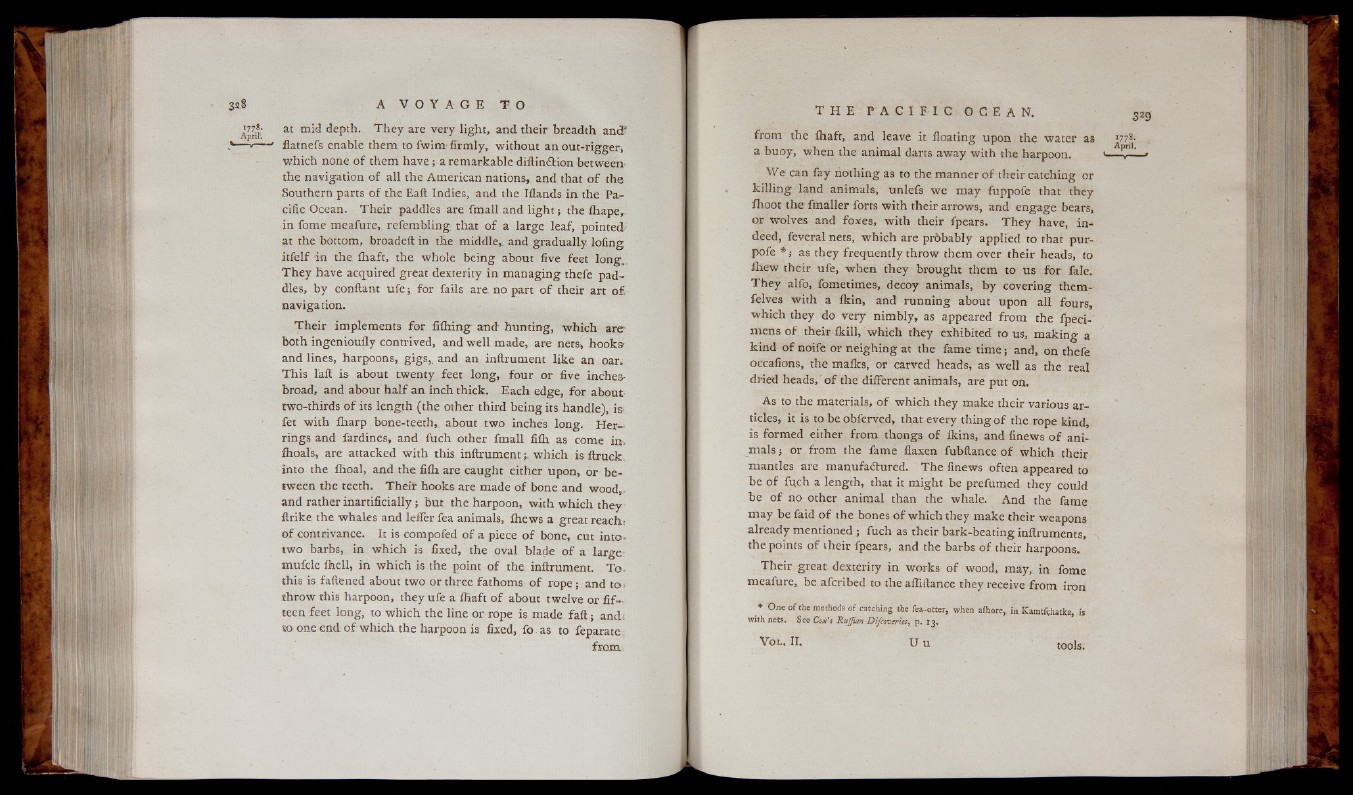
Ill' flip Ijij
at mid depth. T h e y are very ligh t, and their breadth and?
flatnefs enable them to fwim' firmly, without an out-rigger,
w hich none o f them h a v e ; a remarkable diftin&ion between-
the navigation o f all the American nations, and that o f the
Southern parts o f the Eaft Indies, and the Iflands in the Pacific
Ocean. The ir paddles are fmall and l ig h t ; the fliape,
in fome meafure, refembling; that o f a large leaf, pointed-
at the bottom, broadeft in the middle,, and gradually, lofing
itfe lf in the iha ft, the whole being about five feet long..
T h e y have acquired great dexterity in mana gin g thefe paddles,
b y conftant ufe;. fo r fails a re no part o f their art o f
navigation.
T h e ir implements fo r fiflring an d hunting, w h ich are"
both ingeniouily contrived, and w e ll made, are nets, ho o k s
and lines, harpoons, gigs,, and an inftrument lik e an oar;
Th is lafl is about twenty feet long , four or five in ch e s
broad, and about h a lf an. inch thick. Each edge, fo r about
two-thirds o f its length (the other third being its handle), is-
fet w ith fharp bone-teeth,. about two inches long. Herrings
and fardines, and fu ch other fmall fifli as come in,
fhoals, are attacked with this inftrumen t; w h ich is ftruck,
into the fhoal, and the fifh are caught either upon, or between
the teeth. T h e it hooks are made o f bone and wood,,
and rather in a r tific ia lly ; but the harpoon, with w hich they
ftrike the whales and letter fea animals, fhews a great reach-
o f contrivance. It is compofed o f a piece o f bone, cut into ,
two barbs, in w hich is fixed, the ovaL blade o f a large-
m u ffle fhell, in w h ich is the point o f the inftrument. T o .
this is fattened about two or three fathoms o f ro p e ;. and to >
throw this harpoon, they ufe a lliaft o f about twe lve or fifteen
feet long, to which the line or rope is made fa i l ; andi
to one end o f w h ich the harpoon is fixed, fo as to feparate;
from.
from the ihaft, and leave it floating upon the water as
a buoy, when the animal darts awa y with the harpoon.
We can fay nothing as to the manner o f their catching or
k illin g land animals, unlefs w e ma y fuppofe that they
Ihoot the fmaller forts with their a rrows, and eng ag e bears,
or wolves and fo xe s, with their fpears. T h e y have, indeed,
feveral nets, w h ich are prbbably applied to that purpofe
* ; as they frequently throw them over their heads, to
ihew their ufe, when they brought them to us for fale.
T h e y alfo, fometimes, decoy animals, b y covering themfelves
with a ikin , and runn in g about upon all fours,
which they do very nimbly, as appeared from the fpeci-'
mens o f their fkill, which they exhibited to us, m a k in g a
k ind o f noife or n e igh in g at the fame tim e ; and, on thefe
occafions, the maiks, or carved heads, as w e ll as the real
dried heads, o f the different animals, are put on.
As to the materials, o f w hich they make their various articles,
it is to be obferved, that every thing o f the rope kind,
is formed either from thongs o f ikins, and finews o f animals
5 or from the fame flaxen fubftance o f which their
mantles are manufactured. T he finews often appeared to
be o f fuch a length, that it might be prefumed they could
be o f no other animal than the whale. And the fame
ma y be faid o f the bones o f which they make their weapons
already mentioned ; fuch as their bark-beating inftruments,
the points o f their fpears, and the barbs o f their harpoons.
Th e ir great dexterity in works o f wood, may, in fome
meafure, be afcribed to the afiiftance they receive from iron
* One o f the methods o f catching the fea-otter, when a (hare, in Kamtfchatka, is
with nets. See Cox’s Ruffian DifcQveries, p.. 13«
1778.
April.
m